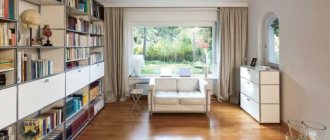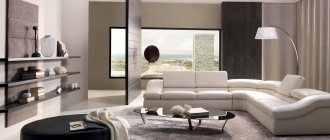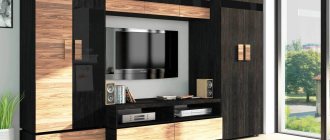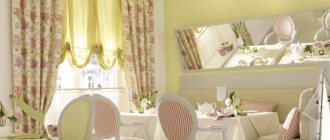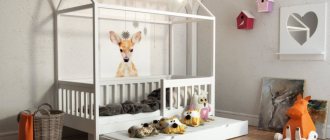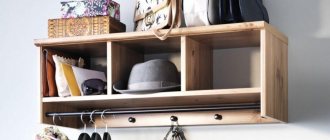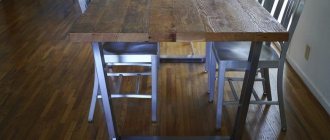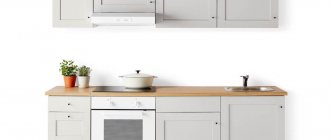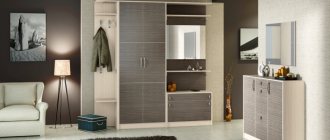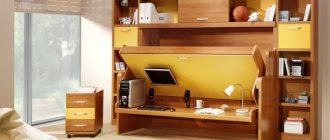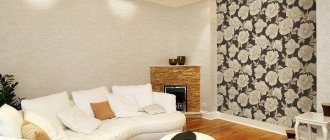Issues discussed in the material:
- What is modular furniture
- What are the advantages of modular furniture
- In which rooms and how can modular furniture be used?
- What styles of modular furniture are popular today?
- How to choose the right modular furniture
What is modular furniture and how does it differ from cabinet furniture? How to make the right choice and find the ideal option that suits you? In this article we will give answers to these and other questions. After all, today the phrase “modular furniture” is very popular, but not everyone understands what it means and what is the fundamental difference between modular and cabinet furniture. Let's figure it out.
Module options
A large system may consist of 10-20 modules:
- dresser;
- display cabinet;
- bed;
- dressing table;
- mirror;
- desk;
- open shelf;
- coffee table;
- display cabinet;
- wall cabinet with a blank facade;
- cabinet-pencil case.
The list is not exhaustive. Manufacturers usually divide large modular systems into parts. Thus, furniture is placed in several rooms: in the living room and bedroom, in the hallway and in the office.
Features and advantages of typesetting structures
Modular systems have appeared on the market relatively recently. They are a set of elements that can be arranged in any order. This solution expands design possibilities when arranging a home. The interior of the living room usually uses stacked sofas and walls.
The designs consist of separate functional blocks that can be combined based on individual preferences. This is the main difference between modular sets and traditional furniture. Modules can be compared to construction kit parts that are used when the need arises. The main advantages of typesetting systems include:
- wide range - functional blocks vary in shape, size, purpose;
- practicality - each element is selected separately, ensuring maximum ease of use;
- mobility - modules can be installed anywhere;
- unified style - items included in one series are made in a common design;
- financial accessibility - the systems are budget-friendly and are cheaper than free-standing pieces of furniture.
With modular systems, the interior acquires the effect of lightness and airiness, which cannot be achieved with bulky cabinet models.
The popularity of stacked designs is explained by the possibility of convenient combination: someone will want to place all the pieces of furniture along the wall, while others are more impressed by their combination into separate, independent sections and arrangement in the room in any order. This advantage is very valuable, because it allows you to periodically update a boring environment.
Wide range Practicality
Mobility
Financial inclusion
Living room modules
You don't have to buy the whole system - you can buy just a few items to decorate your living room. Modular living rooms are highly functional - there is room for books, dishes, souvenirs, music records, and a TV. At the same time, the furniture does not overload the interior.
Modules can be horizontal and vertical, narrow and tall, open and closed, which makes the process of filling the living room very flexible. Thanks to the different configurations of the elements, the room acquires a unique look, even with a set from the mass market.
The furniture in the living room can be folded like a modular picture: the parts are placed close together or at a distance from each other. Elements are placed symmetrically or asymmetrically; the second option is often chosen as more interesting.
Hallway
This is usually the smallest room in an apartment or house and also needs furnishing. The minimum set of modular furniture for a hallway consists of a bedside table for shoes and a hanger for outerwear, however, if the size of the room allows, a spacious wardrobe and a whole system of storage spaces can be installed here.
An original designer set of modules for storing shoes and all kinds of small items. In this case, it is made of metal, but most often modular furniture is created from wood (beech, pine, walnut, oak), MDF, chipboard and other wood-based materials. By the way, the cheapest option for such a kit is plastic boxes. The main feature is that such boxes can be arranged literally any way you like - in one row, in the form of a multi-story structure, and so on.
Very light, light, quite compact and at the same time accommodating everything you need, modular furniture in a classic style will become the main decoration of the hallway and completely solve the problem of storing shoes and outerwear
When choosing modular furniture for the hallway, you should pay attention not only to its size and functionality, but also to how well its external parameters will be combined with the overall design style of the apartment. It should be remembered that the hallway is the first room where guests enter, so you should not neglect the opportunity to make a favorable first impression and amaze with an original and thoughtful design.
Cushioned furniture
Modular upholstered furniture for the living room is usually a large transformable sofa. The sofa consists of several modules - armchairs and additional pouf blocks: the blocks can be assembled and disassembled, and can be used to create small sofa shapes.
Materials
The following materials are used in the manufacture of living room modules:
- natural wood;
- (L)chipboard and MDF;
- plastic;
- glass;
- metal.
The body is made of regular or laminated chipboard - a durable and inexpensive material widely used in the modern furniture industry.
For facades, especially durable and moisture-resistant MDF panels are often chosen - they look presentable, and the surface is sometimes indistinguishable from natural wood.
Glass is used for cabinet doors and display cabinets - almost no modular system for a living room can do without them. One of the fashion trends of recent years is the absence of front fittings: smooth glossy facades without handles look especially impressive and modern.
Bathrooms and kitchens
Nowadays, most bathroom and kitchen sets are produced based on the module principle. The only difference is in the “pitch” of the module and the material (moisture-resistant chipboard or MDF is used). A set for a living room has a width of 40 to 60 centimeters or more, and for kitchens and small bathrooms narrow sections of twenty centimeters are made.
Design
Furniture modules for the living room, like any other furniture, are produced in a variety of styles. The main differences between them are in color and decor.
Eco style
For the current eco-style, it is important to use natural materials, such as solid wood and glass, and minimalist design. A modular wall in the living room, made in eco-style, has simple smooth lines, is equipped with minimal fittings, and alternative methods for opening and closing the door are often used. Open shelves are used for potted indoor plants.
The color of the facades depends on the type of wood. Light-colored furniture looks more natural and makes the room more cheerful. Surfaces are treated so as not to disturb the natural structure of the wood.
Modular (design) systems
Catalog
- Trade equipment Economy panels and accessories Economy panels
- Inserts for economy panels
- Economy stands for economy panels
- Hooks for economy panels
- Brackets for economy panels
- Baskets for economy panels
- Boxes for economy panels
- Holders for economy panels
- Shelves for economy panels
- Stoplocks clamps for hooks
- Trade crosspanel and accessories
- Shelf price holders
- Wall plastic pockets
- Plastic frames, information pockets
- Hanging in loft style
- Joker 25 system
- Wooden hangers and hangers
- Metal wall racks
- Label guns and accessories
- Female mannequins
- Fitting rooms
- Trading grids (grids)
- Vertical/NeoFix system
- Booklets
- Stands for glasses
- Currency detectors
- Leather and flocked jewelry stands
- Sales baskets, storage bins
- Trade tents, marquees
- Hooks for perforated MDF panels
- Washing baths
- Trade equipment for pharmacies
- Accessories, interfaces, consumables, electrical tape Accessories, antennas, couplers, hex screws, electrical tape
- Coaxial, broadband
- Parking sensors, sensors, displays
- processors, crossovers
- Voltmeters, ammeters
- Podiums, shelves, rings, blanks
- Batteries, generators, regulators, mounts
- Keychains, mugs, flags, lighters
- 10″
- Keychain covers
- 2 channel
- Installation of additional equipment and various services
- Vibration isolation materials
- Thermal leather, vinyl, Alcantara
- Spacer rings for speakers, blanks, dies
- Lamps LED, XENON, HALOGEN
- Anti-gravel (armor films), vinyl
- Packages
- Antiseptics
- Furniture locks
- Fire extinguishers
- Power supplies and dimmers for LED strips and lamps
- Floor mirrors
About company
- About Us
- Catalog
- Production
- Store design
- Portfolio
- Contacts
- Requisites
Information
- Store addresses
- Blog
- News
- Shipping and payment
- Product return procedure
- Policy regarding the processing of personal data
Cooperation
- For partners
- For dealers
Modern style
There are practically no restrictions for modern style. Beige, milky, and chocolate shades are chosen as the main color. A typical move for a modern interior is to dilute the traditional color palette with an unusual accent color: on the main wall, against which a low TV stand and a dark brown cabinet with matte surfaces are placed, hang an L-shaped olive-colored cabinet with glossy fronts.
In modern living rooms, a game of contrast is appropriate. The most popular combination is black and white. For a small room or studio, modular living rooms with a corner wardrobe are suitable - the use of corners saves valuable space.
Palace classics
Modular options are also possible in this highly decorative style. In this case, it is better to maintain symmetry as one of the style requirements and place two cabinets, and between them - a low cabinet.
Modular wardrobes for the living room in a palace style are made in light colors, the facades are decorated with abundant baroque decor, and the legs are made of curly shapes.
Saving living space
In a small apartment, no matter how much you would like, it is impossible to install large wardrobes. Otherwise, you will take up an already tiny space with such furniture. You will have to forget about even a minimal sense of comfort, not to mention functionality.
The modules easily fit into your “situation”, and if the need arises, you can select and build in the required element.
Ethnic
Among ethnic styles, Japanese is very popular. It is characterized by brevity and squatness; there are almost no large forms. A classic modular set - double-door wardrobes and a low cabinet.
The top is designed to look like the curved roof of a pagoda, only in a more restrained version. The modules are made of solid wood. The wood is stained to achieve a dark shade and coated with matte varnish.
Mixed
In a mixed-type living room, the use of elements from different directions is allowed. This must be done very carefully and tastefully. A good example is to take eco-style as a basis and add a cabinet and a high-tech hanging cabinet: light natural and steel gray shades go well together.
A more risky option is High-tech and classic: at least two items must be from the palace collection, for example, a double-door wardrobe and a chest of drawers.
Minimalism
The complete antipode of the Art Nouveau style set is hi-tech furniture. Production is based on the motto “minimum items”. Minimalism will be perfect for people with progressive views.
Hi tech is defined by the following criteria:
- Limited number of colors.
- Lack of curls and smooth lines in favor of quadrangle and circle shapes.
- The space is free of unnecessary elements.
The modular system in the living room in high-tech style is minimalistic and futuristic.
A contrasting solution creates brightness for the room and expressiveness for the furniture.
Advantages of modular furniture
General advantages of modular systems:
- uniform style and design of modules;
- any configuration with any number of elements;
- replacement or additional purchase of modules;
- ease of transportation of compact furniture.
Among the particular positive aspects, it can be noted that for small apartments and studios, modular systems are simply a godsend: narrow and wall cabinets save space and make the living room more airy - the modules seem to “float” in the air at different distances from the floor.
With the help of modules, a large apartment can be decorated in a single key with the living room and create the effect of a smooth transition between rooms for different purposes.
A serious disadvantage of a modular system is that when purchasing individual modules, the cost of each item will be higher than when purchasing the entire system. Before making your final choice, it is better to fully prepare the living room project.
Furniture stores offer a wide selection of modular living room sets from domestic and foreign manufacturers. Photos of modular living rooms will help you decide on the style and choose the placement option.
Price
Such furniture is much cheaper than custom-made individual solutions.
Having a large selection of design options from each seller will allow you to find the optimal solution for a specific situation - on the spot, in the store. With all that said above, modular furniture does have certain disadvantages - and it is important to know them before making a purchasing decision. Firstly, this is the presence of furniture of exclusively standard dimensions - you will have to carefully think through and measure the room before purchasing. Secondly, restrained forms and design; you shouldn’t expect any frills in this regard. But these are small things compared to the truly valuable benefits of modular furniture. It will find its rightful place in almost every home. Have a successful and enjoyable purchase in our online store of Belarusian furniture, we will be happy to help you create the ideal modular solution! Category: Articles
